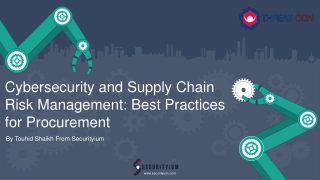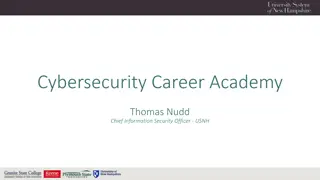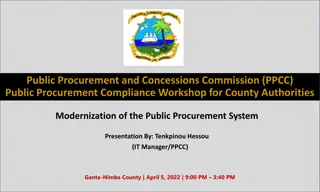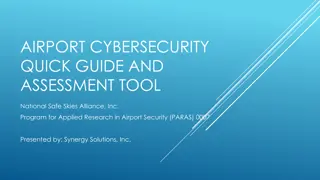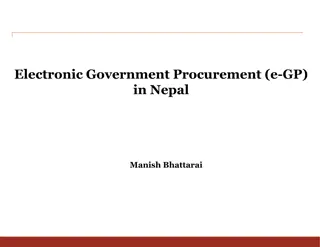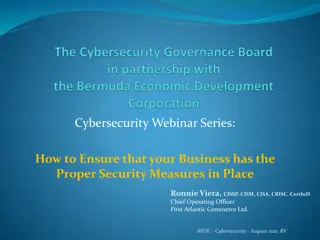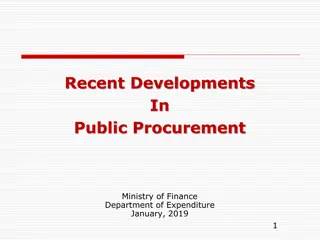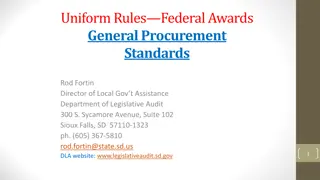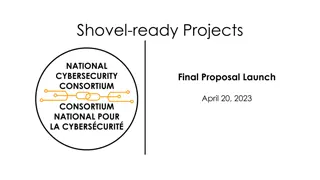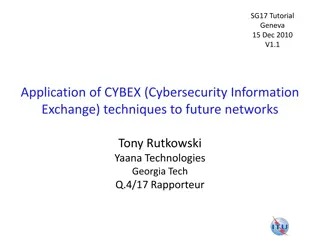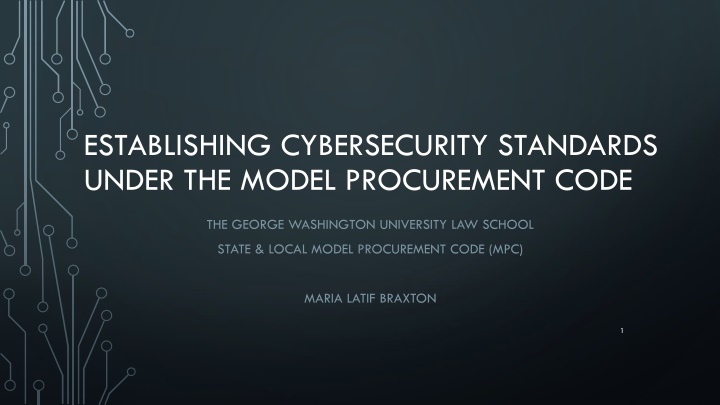
Establishing Cybersecurity Standards under Model Procurement Code
This presentation delves into how the Model Procurement Code (MPC) could provide guidance on cybersecurity for state and local governments and their contractors. It assesses cybersecurity pillars, relevant laws, rules, and guidance, and the absence of cybersecurity guidance in the MPC.
Download Presentation

Please find below an Image/Link to download the presentation.
The content on the website is provided AS IS for your information and personal use only. It may not be sold, licensed, or shared on other websites without obtaining consent from the author. If you encounter any issues during the download, it is possible that the publisher has removed the file from their server.
You are allowed to download the files provided on this website for personal or commercial use, subject to the condition that they are used lawfully. All files are the property of their respective owners.
The content on the website is provided AS IS for your information and personal use only. It may not be sold, licensed, or shared on other websites without obtaining consent from the author.
E N D
Presentation Transcript
ESTABLISHING CYBERSECURITY STANDARDS UNDER THE MODEL PROCUREMENT CODE THE GEORGE WASHINGTON UNIVERSITY LAW SCHOOL STATE & LOCAL MODEL PROCUREMENT CODE (MPC) MARIA LATIF BRAXTON 1
INTRODUCTION This presentation assesses how the MPC could implement guidance on cybersecurity for state and local Governments and their contractors. 2
WHAT IS CYBERSECURITY The main pillars of a successful and holistic cybersecurity program using 6 main functions (https://www.nist.gov/cyberframework) 3
AGENDA CONSIDERATIONS MPC CYBERSECURITY GUIDANCE OMB GUIDANCE FEDERAL STATUTE FAR DFARS CONCLUSION 4
DHS ANNOUNCES ADDITIONAL $374.9 MILLION IN FUNDING TO BOOST STATE, LOCAL CYBERSECURITY Department of Homeland Security announced the availability of $374.9 million in grant funding for the Fiscal Year (FY) 2023 State and Local Cybersecurity Grant Program (SLCGP). The SLCGP is a first-of-its-kind cybersecurity grant program specifically for state, local, and territorial (SLT) governments across the country to help them strengthen their cyber resilience. Established by the State and Local Cybersecurity Improvement Act, and part of the Bipartisan Infrastructure Law, the SLCGP provides $1 billion in funding over four years to support SLT governments as they develop capabilities to detect, protect against, and respond to cyber threats. In today s threat environment, any locality is vulnerable to a devastating cyber attack targeted at a hospital, school, water, or other system, said Secretary of Homeland Security Alejandro N. Mayorkas. SLCGP is jointly administered by the Cybersecurity and Infrastructure Security Agency (CISA) and the Federal Emergency Management Agency (FEMA). CISA provides expertise and guidance on cybersecurity issues while FEMA manages the grant award and allocation process. https://www.dhs.gov/news/2023/08/07/dhs-announces-additional-3749-million-funding-boost-state-local- cybersecurity#:~:text=Established%20by%20the%20State%20and,and%20respond%20to%20cyber%20threats. 5
RELEVANT LAWS, RULES AND GUIDANCE MPC (Model Procurement Code) OMB (Office of Management and Budget) Federal Statutes (FISMA), 44 U.S.C. 3551 et seq., Public Law (P.L.) 113-283 FAR DFARS 6
MPC CYBERSECURITY GUIDANCE No cybersecurity guidance in MPC or model implementing regulations MPC discusses bid security Appropriate security for electronic transmissions Nothing that speaks to cybersecurity 7
OMB GRANTS GUIDANCE No current guidance with respect to cybersecurity. OMB Grants guidance impacts state and local grantees Proposed revised OMB guidance would allow grantees to apply cybersecurity costs as direct costs and calls for security measures OMB GUIDANCE OMB Memorandum M-22-09, Moving the U.S. Government Toward Zero Trust Cybersecurity Principles, requires agencies to meet cybersecurity objectives by the end of Fiscal Year (FY) 2024. 8
FEDERAL STATUTE Federal Information Security Modernization Act (FISMA), 44 U.S.C. 3551 et seq., Public Law (P.L.) 113-283. The Federal Information Security Management Act (FISMA) is United States legislation that defines a framework of guidelines and security standards to protect government information and operations. Not binding on state and local governments The Federal Information Security Modernization Act of 2014 (FISMA 2014) updates the Federal Government's cybersecurity practices by: Codifying Department of Homeland Security (DHS) authority to administer the implementation of information security policies for non-national security federal Executive Branch systems, including providing technical assistance and deploying technologies to such systems 9
FAR COUNCIL PROPOSED RULES On October 3, 2023, the Federal Acquisition Regulation (FAR) Council released two new proposed rules on unclassified Federal IT systems and cyber incident reporting. Standardizing Cybersecurity Requirements for Unclassified Federal Information Systems Set of minimum cybersecurity standards to all Federal Information Systems (FIS) Contractors will have to provide the Cybersecurity and Infrastructure Security Agency (CISA) access to the system and assist with inspections. Cloud FISs have the same minimum requirements, but the Government must also identify the FedRAMP authorization level, and contractors must match FedRAMP security, privacy, and continuous monitoring requirements. Cyber Threat and Incident Reporting and Information Sharing Contractors will be required to develop and maintain a software bill of materials (SBOM), which records details about the components of software, for any software used in the performance of the contract regardless of whether there is any security incident. Contractors must cooperate with CISA and allow full access to their systems for threat hunting and incident response and must report all security incidents and submit information to CISA within 8 hours of discovery with updates every 72 hours until resolution 10 Contractors must implement Internet Protocol Version 6 (IPv6) as described by the Office of Management and Budget. https://thecgp.org/2023/10/05/friday-flash-10-06-23/#cyber
FAR FAR 52.204-21 imposes a set of fifteen (15) basic cybersecurity controls for contractor information systems upon which Federal contract information is stored, processed or transmitted. FAR Part 40 this is an effort to amend the FAR to create a new FAR part, Part 40, which will be the single, consolidated location for cybersecurity supply chain risk management requirements. It is unclear at this point which FAR clauses will be included in this section. OMB listed this proposed FAR measure in the Final Rule Stage 11
DFARS The Defense Federal Acquisition Regulation Supplement (DFARS) is a set of regulations that apply to all U.S. Department of Defense (DoD) contracts and subcontracts. The DFARS is meant to guarantee the integrity of Controlled Unclassified Information (CUI), or sensitive information belonging to the government that third-parties such as suppliers, partners, and trade associations may hold or use. DFARS Subpart 204.73 speaks to safeguarding covered defense information and cyber incident reporting 12
IMPLEMENTING NIST TO PROTECT NETWORKS AND DATA President Barack Obama, on February 12, 2013, issued Executive Order 13636 entrusting the National Institute of Standards and Technologies (NIST) the development of the Cybersecurity Framework for the protection of critical infrastructures, The NIST Cybersecurity Framework 2.0 provides guidance to industry, government agencies, and other organizations to reduce cybersecurity risks and designed to be used by organizations of all sizes and sectors Has been successfully leveraged by many governments and other organizations outside of the United States. U.S. federal government agencies and contractors generally must comply with NIST SP 800 53. Many state and local governments and private organizations use NIST SP 800 53 as their security controls framework. StateRAMP is a non-profit organization that helps state and local governments find cloud service providers (CSPs) that meet cybersecurity standards. 13 StateRAMP encourages state and local government to follow NIST SP 800-53
NIST SP 800-53 Organizations that need to implement security and privacy controls to protect their information systems and assets can use NIST SP 800-53. It provides a comprehensive catalog of controls that can be customized to meet specific requirements and help organizations manage risk effectively. These controls are designed to protect organizational operations, assets, individuals, and the nation from a wide range of threats and risks, such as hostile attacks, human errors, natural disasters, and privacy risks 14
CONCLUSION There is no guidance with respect to cybersecurity in the MPC for organizations to follow as a basic guideline The MPC should point to NIST standards as defined in the NIST Cybersecurity Framework to aid organizations in establishing effective cybersecurity measures 15
Maria Latif Braxton Mlatif1983@gmail.com The author is a procurement analyst support the Army Chief of Chaplains. Any views expressed are hers alone. 16

